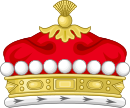
1st Viscount Esher
Viscount Esher, of Esher in the County of Surrey, is a title in the Peerage of the United Kingdom. [1] It was created on 11 November 1897 for the prominent lawyer and judge William Brett, 1st Baron Esher, upon his retirement as Master of the Rolls. He had already been created Baron Esher, of Esher in the County of Surrey, on 24 July 1885, also in the Peerage of the United Kingdom. [2] His son, the second Viscount, was a Liberal politician and historian. His grandson, the fourth Viscount, was a noted architect. As of 2010 [update] the titles are held by the latter's son, the fifth Viscount, who succeeded in 2004.
Contents
The family seat is Beauforest House, near Newington, Oxfordshire.[ citation needed ]


